
PetLamp
Press Release StoreIn this project we advocate for reuse as a sustainable alternative to recycling, driven by the inherent contradiction of PET bottles: their brief utility compared to their extended decomposition period and resource-intensive production. Despite this, PET bottles are widely used for their effectiveness, affordability, and practicality. Our mission is to extend the lifespan of these bottles, transforming them into cohesive, functional, and appealing products for the long term.
Inspiration for repurposing PET bottles came from the Japanese bamboo tea ceremony's bamboo stirrer. Both objects share common elements, such as being made from a single material and featuring structural elements and flat surfaces suitable for weaving. Analyzing PET bottles as industrial objects revealed traces of their manufacturing process, providing references for cutting and shaping.
Our approach breathes new life into PET bottles by fusing one of the most produced industrial items with a deeply rooted traditional craft. We transform bottles from liquid containers into ceiling lamps, utilizing their tops for electrical components, their necks as structural elements, and their bodies as weaving surfaces. The weaving process reinterprets traditional techniques, and the artisan's work conveys a rich tradition through fibers, colors, and motifs.
The PET Lamp project aligns with our mission to address a global issue, the disposal of plastic PET bottles, through a local craft, the basket weaving tradition.


- The issue. Sketches by PET Lamp

- The inspiration: Bamboo stirrer. Photo by PET Lamp

- PET Lamp design process. Sketches by PET Lamp
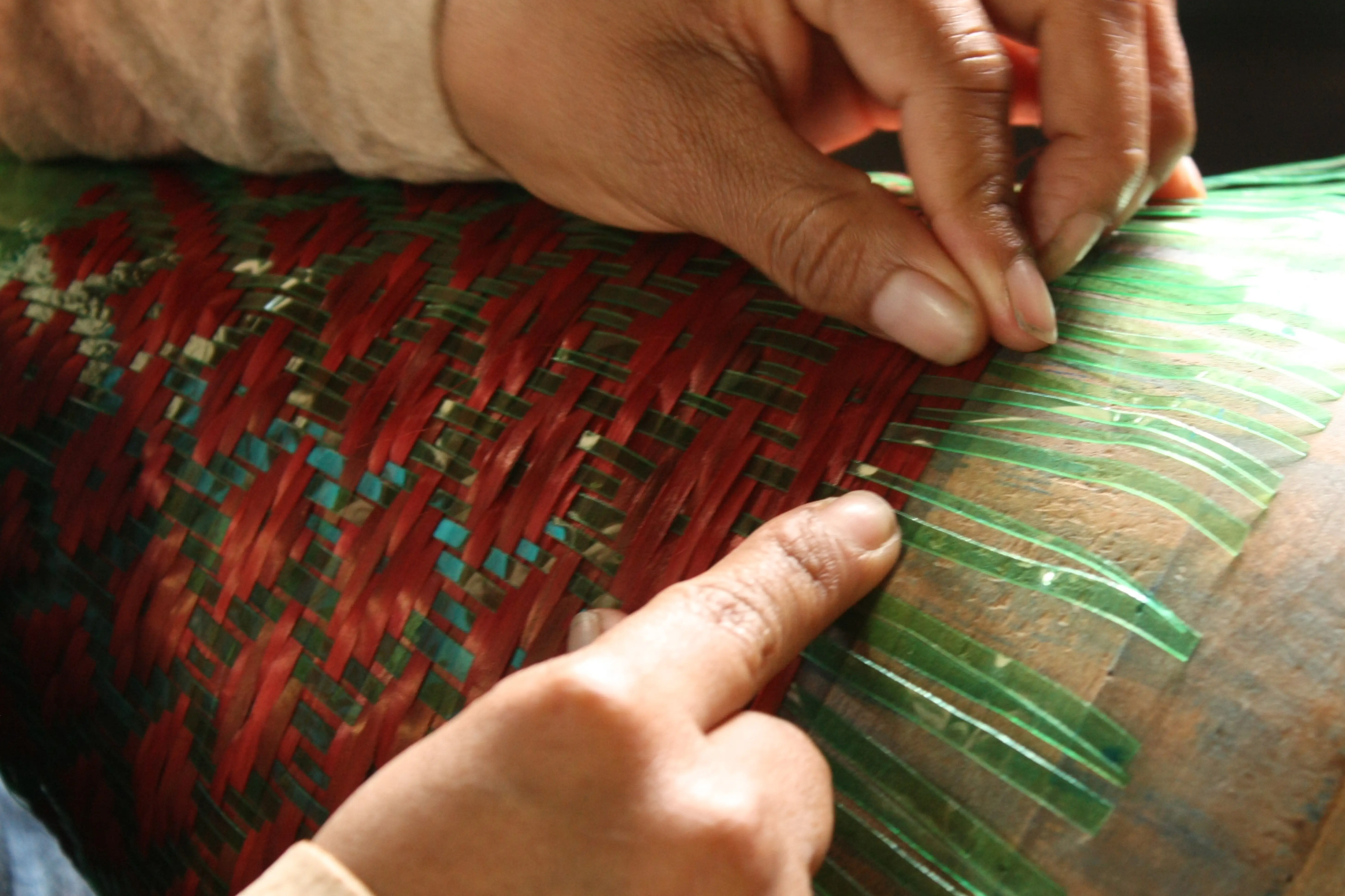
- The weaving process close-up. Photo by PET Lamp

- The weaving process. Photo by PET Lamp
PetLamp

In this project we advocate for reuse as a sustainable alternative to recycling, driven by the inherent contradiction of PET bottles: their brief utility compared to their extended decomposition period and resource-intensive production. Despite this, PET bottles are widely used for their effectiveness, affordability, and practicality. Our mission is to extend the lifespan of these bottles, transforming them into cohesive, functional, and appealing products for the long term.
Inspiration for repurposing PET bottles came from the Japanese bamboo tea ceremony's bamboo stirrer. Both objects share common elements, such as being made from a single material and featuring structural elements and flat surfaces suitable for weaving. Analyzing PET bottles as industrial objects revealed traces of their manufacturing process, providing references for cutting and shaping.

- The issue. Sketches by PET Lamp

- The inspiration: Bamboo stirrer. Photo by PET Lamp

- PET Lamp design process. Sketches by PET Lamp

- The weaving process close-up. Photo by PET Lamp

- The weaving process. Photo by PET Lamp
Our approach breathes new life into PET bottles by fusing one of the most produced industrial items with a deeply rooted traditional craft. We transform bottles from liquid containers into ceiling lamps, utilizing their tops for electrical components, their necks as structural elements, and their bodies as weaving surfaces. The weaving process reinterprets traditional techniques, and the artisan's work conveys a rich tradition through fibers, colors, and motifs.
The PET Lamp project aligns with our mission to address a global issue, the disposal of plastic PET bottles, through a local craft, the basket weaving tradition.

Eperara Siapidara
In 2012, the PET Lamp Team embarked on its inaugural PET Lamp Project in Colombia. In collaboration with Artesanías de Colombia, we partnered with two unique indigenous communities: the Eperara-Siapidara and the Guambianos. These communities, originating from the Cauca region, found themselves grappling with poverty in Bogota, having been displaced due to conflicts.
Our PET Lamp Eperara Siapidara is skillfully woven from the meticulously stripped leaves of the Paja Tetara palm tree, a prevalent resource in the Cauca region of Western Colombia, the place of origin for our Eperara-Siapidara artisans.
These talented artisans enhance the palm strips with vivid, natural pigments, highlighting the intricate traditional patterns they delicately weave into the lampshades. With full creative freedom, they have the liberty to apply these motifs and colors as they see fit, resulting in each PET Lamp Eperara being a unique manifestation of the artisan's inspiration at the moment of creation.

- Pianca stand at Milano Rho Salone. Photo by Pianca

- Hands detail weaving Eperara Siapidara. Photo by PET Lamp

- Hands detail matching Eperara Siapidara colors. Photo by PET Lamp

- Making of Eperara Siapidara. Photo by PET Lamp

- Making of Eperara Siapidara. Photo by PET Lamp

- Making of Eperara Siapidara detail. Photo by PET Lamp

- Domingo Ulluríe, Emerita Chirimio, Manuela Dura, Liliana Grueso, María Celina, Mélida Valencia, Marta Cesilia Cuchillo, María Stella Cuchillo. Photo by PET Lamp

- Team Portrait. Photo by PET Lamp

- Eperara Siapidara. Photo by PET Lamp

- Eperara Siapidara set of 12. Photo by PET Lamp

- Tejada Mar Barcelona Restaurant, designed by EM Studio Barcelona. Photo by Albert Font

- Exhibition at VitraHaus, Weil am Reim, Germany. Photo by VitraHaus
Eperara Siapidara

In 2012, the PET Lamp Team embarked on its inaugural PET Lamp Project in Colombia. In collaboration with Artesanías de Colombia, we partnered with two unique indigenous communities: the Eperara-Siapidara and the Guambianos. These communities, originating from the Cauca region, found themselves grappling with poverty in Bogota, having been displaced due to conflicts.
Our PET Lamp Eperara Siapidara is skillfully woven from the meticulously stripped leaves of the Paja Tetara palm tree, a prevalent resource in the Cauca region of Western Colombia, the place of origin for our Eperara-Siapidara artisans.
These talented artisans enhance the palm strips with vivid, natural pigments, highlighting the intricate traditional patterns they delicately weave into the lampshades. With full creative freedom, they have the liberty to apply these motifs and colors as they see fit, resulting in each PET Lamp Eperara being a unique manifestation of the artisan's inspiration at the moment of creation.

- Pianca stand at Milano Rho Salone. Photo by Pianca

- Hands detail weaving Eperara Siapidara. Photo by PET Lamp

- Hands detail matching Eperara Siapidara colors. Photo by PET Lamp

- Making of Eperara Siapidara. Photo by PET Lamp

- Making of Eperara Siapidara. Photo by PET Lamp

- Making of Eperara Siapidara detail. Photo by PET Lamp

- Domingo Ulluríe, Emerita Chirimio, Manuela Dura, Liliana Grueso, María Celina, Mélida Valencia, Marta Cesilia Cuchillo, María Stella Cuchillo. Photo by PET Lamp

- Team Portrait. Photo by PET Lamp

- Eperara Siapidara. Photo by PET Lamp

- Eperara Siapidara set of 12. Photo by PET Lamp

- Tejada Mar Barcelona Restaurant, designed by EM Studio Barcelona. Photo by Albert Font

- Exhibition at VitraHaus, Weil am Reim, Germany. Photo by VitraHaus

Chimbarongo
Chimbarongo, renowned as "The Wicker Capital," boasts a longstanding tradition in the wicker industry. As one of the world's major wicker producers, Chile provides us with a comprehensive insight into the basketry tradition, encompassing every aspect from wicker harvesting to storage and preparation before weaving. Wicker is esteemed for its pliability, but it remains a relatively stiff material, typically manipulated by male artisans who work with damp stems to enhance flexibility. Contemporary Chilean artisans now employ their own tools to gauge the width and thickness of wicker stems.
In the process of crafting the PET Lamp, they employ specially designed wooden molds from Madrid to maintain the desired shape. These molds, in conjunction with meticulously measured wicker stems, seamlessly interweave with the plastic strips from PET bottles. The challenge of this project lies in creating a modern design product that adheres to the principles and structure of traditional wicker craftsmanship, with the aspiration that it might one day serve as an alternative means of social integration.

- Dehesa El Milagro, project by Marta de la Rica. Photo by Manolo Yllera

- Hands detail weaving Chimbarongo . Photo by PET Lamp

- Carrying a bunch of wicker. Photo by PET Lamp

- Adjusting the thickness of the fiber. Photo by PET Lamp

- Weaving process of Chimbarongo . Photo by PET Lamp

- Juan Valenzuela, Segundo Rodríguez, Rodolfo Castro, Raúl Briones. Photos by PET Lamp

- Team portrait at Segundo’s workshop. Photo by PET Lamp

- Chimbarongo. Photo by PET Lamp

- Chimbarongo set of 18. Photo by PET Lamp

- 3 Chimbarongo PET Lamps warming up a kitchen. Photo by Ventura Studio

- Los Feliz House, project by Ghislaine. Photo by Garrett Rowland

- Dehesa El Milagro, project by Marta de la Rica. Photo by Manolo Yllera
Chimbarongo

Chimbarongo, renowned as "The Wicker Capital," boasts a longstanding tradition in the wicker industry. As one of the world's major wicker producers, Chile provides us with a comprehensive insight into the basketry tradition, encompassing every aspect from wicker harvesting to storage and preparation before weaving. Wicker is esteemed for its pliability, but it remains a relatively stiff material, typically manipulated by male artisans who work with damp stems to enhance flexibility. Contemporary Chilean artisans now employ their own tools to gauge the width and thickness of wicker stems.
In the process of crafting the PET Lamp, they employ specially designed wooden molds from Madrid to maintain the desired shape. These molds, in conjunction with meticulously measured wicker stems, seamlessly interweave with the plastic strips from PET bottles. The challenge of this project lies in creating a modern design product that adheres to the principles and structure of traditional wicker craftsmanship, with the aspiration that it might one day serve as an alternative means of social integration.

- Dehesa El Milagro, project by Marta de la Rica. Photo by Manolo Yllera

- Hands detail weaving Chimbarongo . Photo by PET Lamp

- Carrying a bunch of wicker. Photo by PET Lamp

- Adjusting the thickness of the fiber. Photo by PET Lamp

- Weaving process of Chimbarongo . Photo by PET Lamp

- Juan Valenzuela, Segundo Rodríguez, Rodolfo Castro, Raúl Briones. Photos by PET Lamp

- Team portrait at Segundo’s workshop. Photo by PET Lamp

- Chimbarongo. Photo by PET Lamp

- Chimbarongo set of 18. Photo by PET Lamp

- 3 Chimbarongo PET Lamps warming up a kitchen. Photo by Ventura Studio

- Los Feliz House, project by Ghislaine. Photo by Garrett Rowland

- Dehesa El Milagro, project by Marta de la Rica. Photo by Manolo Yllera

Abyssinia
The colorful basket weaving of Ethiopia has a long tradition and is common in rural parts of the country, with the Muslim city of Harar being one of the most famous for this craft. The traditional baskets of Ethiopia are categorized as “coiled” baskets. The materials used are usually grasses and palm leaves, which are dyed with other natural materials.
What makes this collection special is the desire to experiment, adapt, and reinterpret concepts. The very flat design of these lamps was inspired by the shape of one of the most typical Ethiopian baskets, which is made with plant fibers and used to serve injera, a traditional flat, circular Ethiopian bread. Generally made by women, the design comes from their own imagination. There are no guidelines or instructions to help in the design of these intricate and colorful pieces.
The concept behind these baskets was reinterpreted and adapted for this collection, adding the bottle as a central part of the structure. The idea behind the weaving process is to create different patterns by rolling natural fibers around dry grasses while constantly seeking a vibrant mix of colors.

- 3 Abyssinia PET Lamps hanging on top of our meeting table at our previous ACdO Studio. Photo by ACdO

- Hands detail weaving Abyssinia . Photo by PET Lamp

- Making of Abyssinia detail . Photo by PET Lamp

- Making of Abyssinia. Photo by PET Lamp

- Kenenye Lemma, Tsega Dereb, Banchyayhu Mulualem, Kasech Demeke, Worknesh Arega. Photos by PET Lamp

- Kasech and Alvaro portrait. Photo by PET Lamp

- Abyssinia. Photo by PET Lamp

- Abyssinia set of 6. Photo by PET Lamp

- PET Lamp Abyssinia launch in Rossana Orlandi’s patio. Photo by PET Lamp
Abyssinia

The colorful basket weaving of Ethiopia has a long tradition and is common in rural parts of the country, with the Muslim city of Harar being one of the most famous for this craft. The traditional baskets of Ethiopia are categorized as “coiled” baskets. The materials used are usually grasses and palm leaves, which are dyed with other natural materials.
What makes this collection special is the desire to experiment, adapt, and reinterpret concepts. The very flat design of these lamps was inspired by the shape of one of the most typical Ethiopian baskets, which is made with plant fibers and used to serve injera, a traditional flat, circular Ethiopian bread. Generally made by women, the design comes from their own imagination. There are no guidelines or instructions to help in the design of these intricate and colorful pieces.
The concept behind these baskets was reinterpreted and adapted for this collection, adding the bottle as a central part of the structure. The idea behind the weaving process is to create different patterns by rolling natural fibers around dry grasses while constantly seeking a vibrant mix of colors.

- 3 Abyssinia PET Lamps hanging on top of our meeting table at our previous ACdO Studio. Photo by ACdO

- Hands detail weaving Abyssinia . Photo by PET Lamp

- Making of Abyssinia detail . Photo by PET Lamp

- Making of Abyssinia. Photo by PET Lamp

- Kenenye Lemma, Tsega Dereb, Banchyayhu Mulualem, Kasech Demeke, Worknesh Arega. Photos by PET Lamp

- Kasech and Alvaro portrait. Photo by PET Lamp

- Abyssinia. Photo by PET Lamp

- Abyssinia set of 6. Photo by PET Lamp

- PET Lamp Abyssinia launch in Rossana Orlandi’s patio. Photo by PET Lamp

Kyoto
In the ancient capital of Kyoto, where many of Japan’s most elaborate fine crafts were established, highly delicate bamboo craftsmanship became one of the city’s signature industries, and master artisans passed their skills and titles—along with their pride—to successive generations. It’s natural that bamboo was treasured as a material even in ancient Japan, as its durable and elastic nature offers strong, straight fibers that keep their shape in dry and humid conditions.
The bamboo fibers are separated and cut one by one to create the structure using elegant and discreet designs.

- Kyoto close-up. Photo by ACdO

- Preparation of the bamboo before weaving. Photo by Yuya Hoshino

- Preparation of the bamboo before weaving. Photo by Yuya Hoshino

- Making of Kyoto detail. Photo by Yuya Hoshino

- Chiemi Ogura in her workshop. Photo by Yuya Hoshino
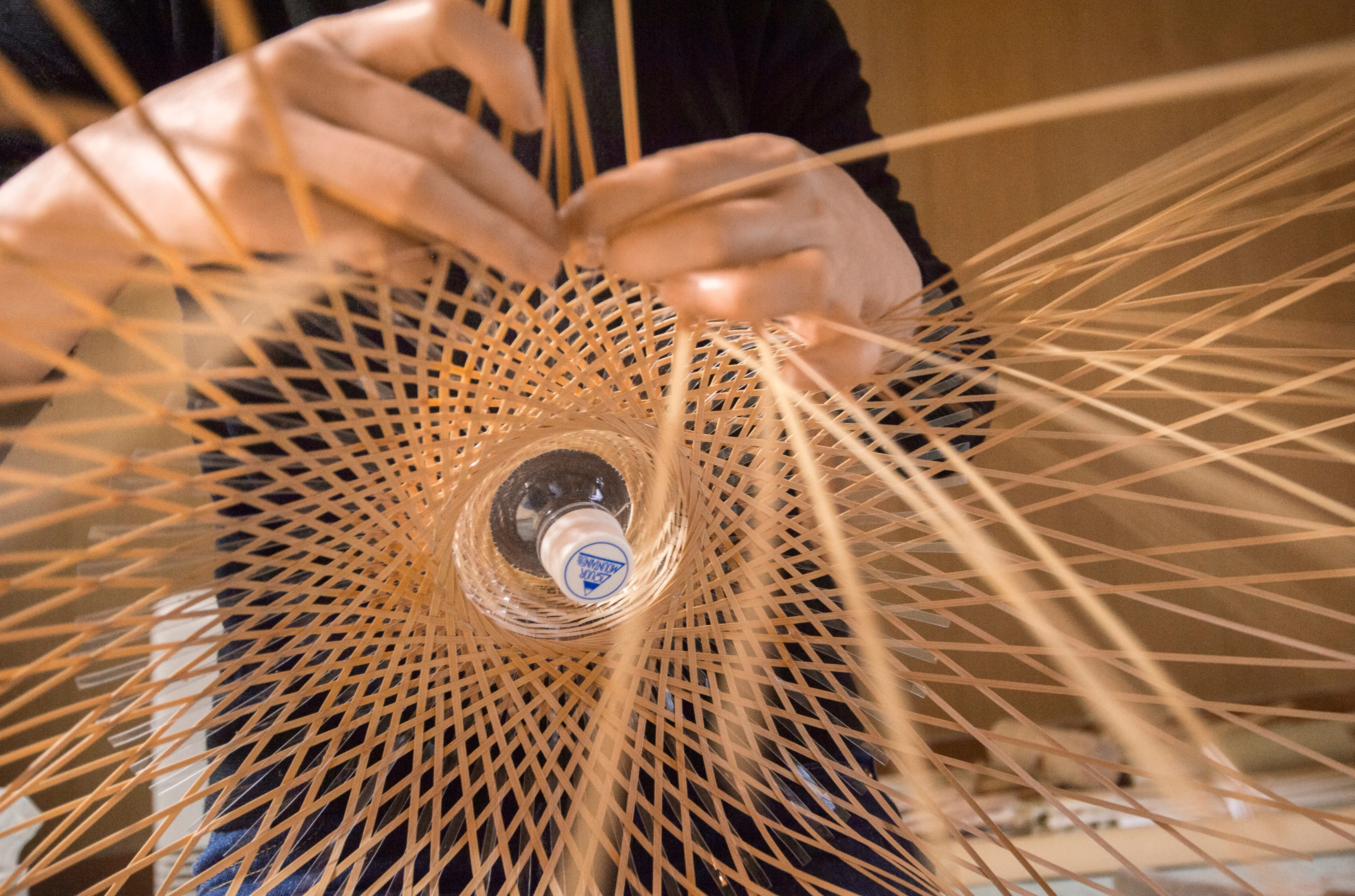
- Making of Kyoto detail. Photo by Yuya Hoshino

- Chiemi Ogura, Hideaki Hosokawa. Photos by Yuya Hoshino

- Kyoto. Photo by PET Lamp
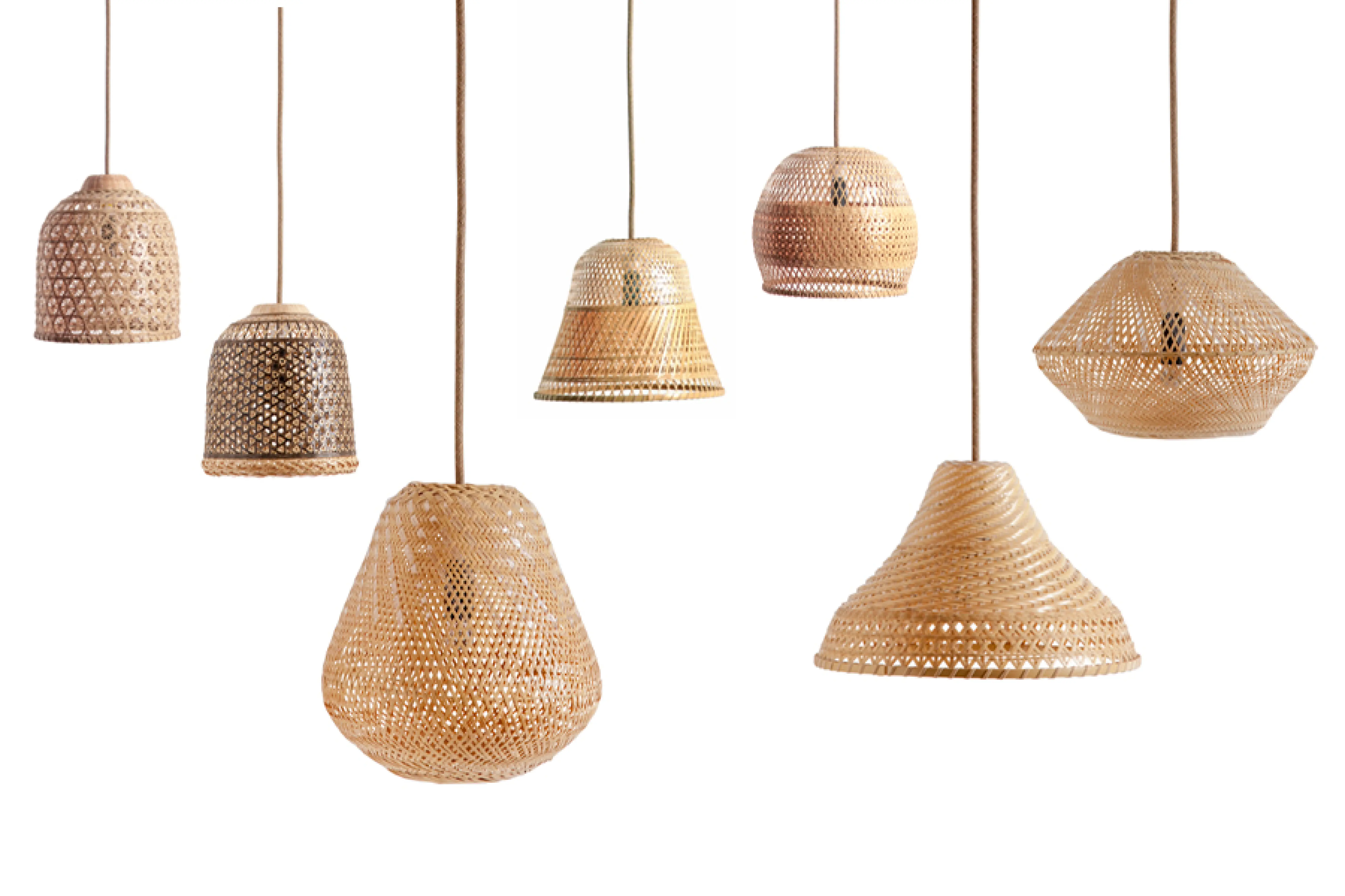
- Kyoto composition. Photo by PET Lamp
Kyoto

In the ancient capital of Kyoto, where many of Japan’s most elaborate fine crafts were established, highly delicate bamboo craftsmanship became one of the city’s signature industries, and master artisans passed their skills and titles—along with their pride—to successive generations. It’s natural that bamboo was treasured as a material even in ancient Japan, as its durable and elastic nature offers strong, straight fibers that keep their shape in dry and humid conditions.
The bamboo fibers are separated and cut one by one to create the structure using elegant and discreet designs.

- Kyoto close-up. Photo by ACdO

- Preparation of the bamboo before weaving. Photo by Yuya Hoshino

- Preparation of the bamboo before weaving. Photo by Yuya Hoshino

- Making of Kyoto detail. Photo by Yuya Hoshino

- Chiemi Ogura in her workshop. Photo by Yuya Hoshino

- Making of Kyoto detail. Photo by Yuya Hoshino

- Chiemi Ogura, Hideaki Hosokawa. Photos by Yuya Hoshino

- Kyoto. Photo by PET Lamp

- Kyoto composition. Photo by PET Lamp

Mapuche
We returned to Chile in 2016, this time to collaborate with the Mapuche women of Huentelolen in the Araucania Region. As usual in our workshops, they guided us through every step of the process leading to the final product. The artisan women work with a natural fiber known as ñocha, which they collect, boil, and then carefully dry, rendering it ready for weaving and shaping.
Each PET Lamp bears the distinctive and personal touch of the artisan who is free to apply colors and time-honored techniques. These women began by learning the art of cutting PET bottles and then proceeded to weave PET strips along with the vegetable fiber, utilizing wooden molds to maintain the predetermined shape. The resulting collection delves into a social community setting, featuring a native fiber and an ancient technique that has been preserved for over five centuries. PET Lamp Mapuche stands as evidence of the ability for positive projects to arise from a region characterized by conflict, actively contributing to elevating the reputation of this stunning area.

- Cooking under a Mapuche PET Lamp in private house in Madrid. Photo by Aina Gutierrez

- Ñocha fibers detail. Photo by PET Lamp
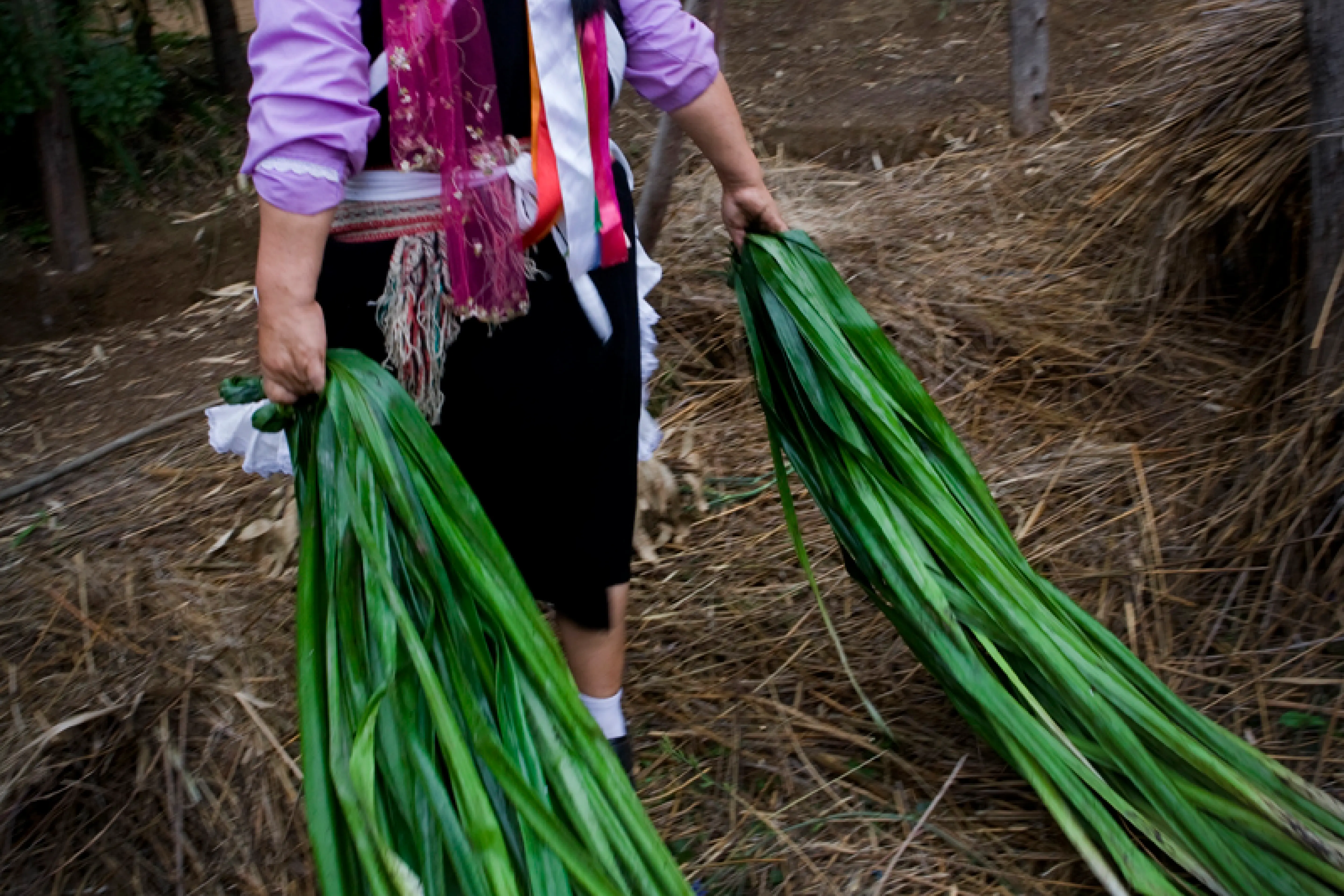
- Collecting Ñocha fibers. Photo by PET Lamp
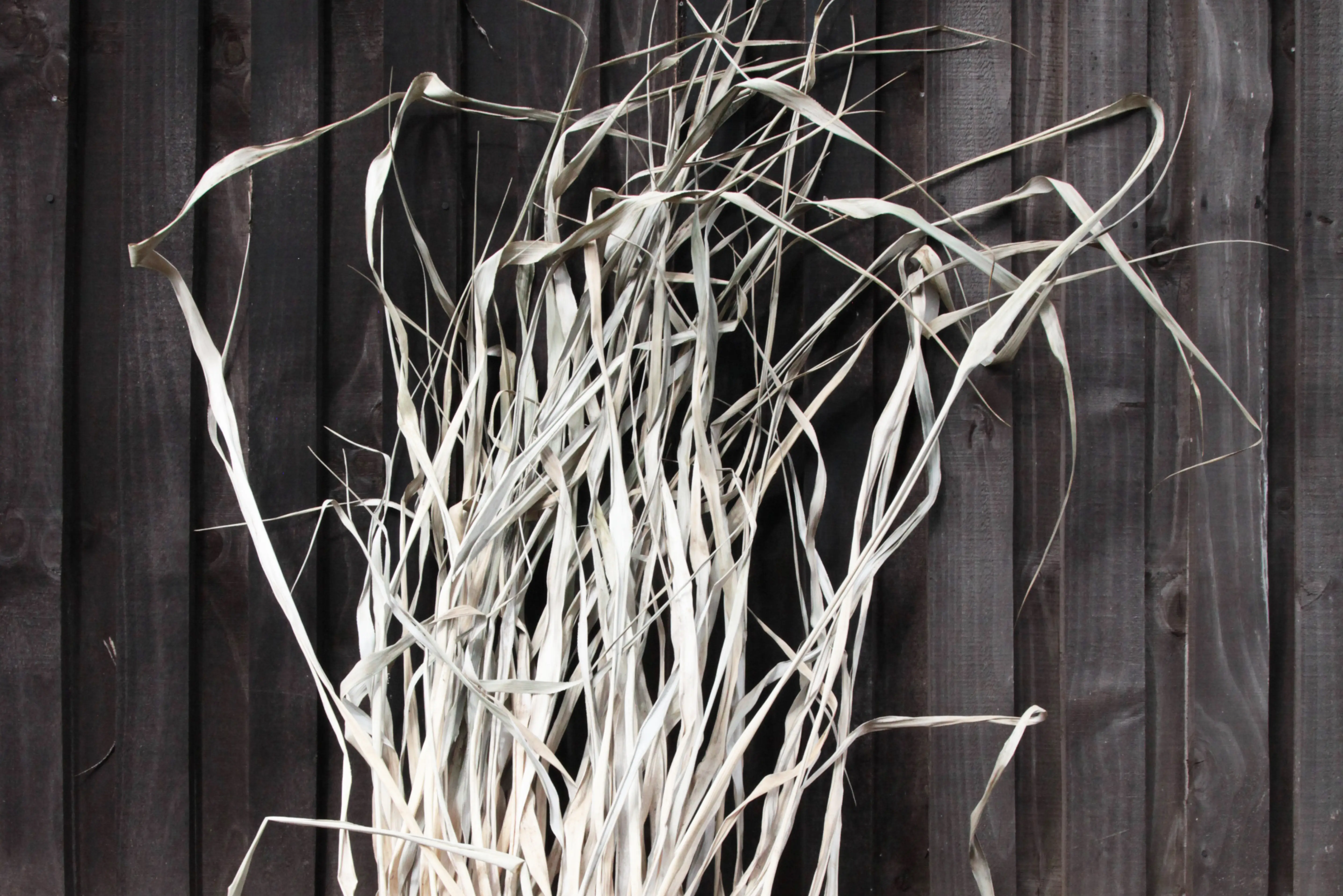
- Ñocha left to dry at the sun. Photo by PET Lamp
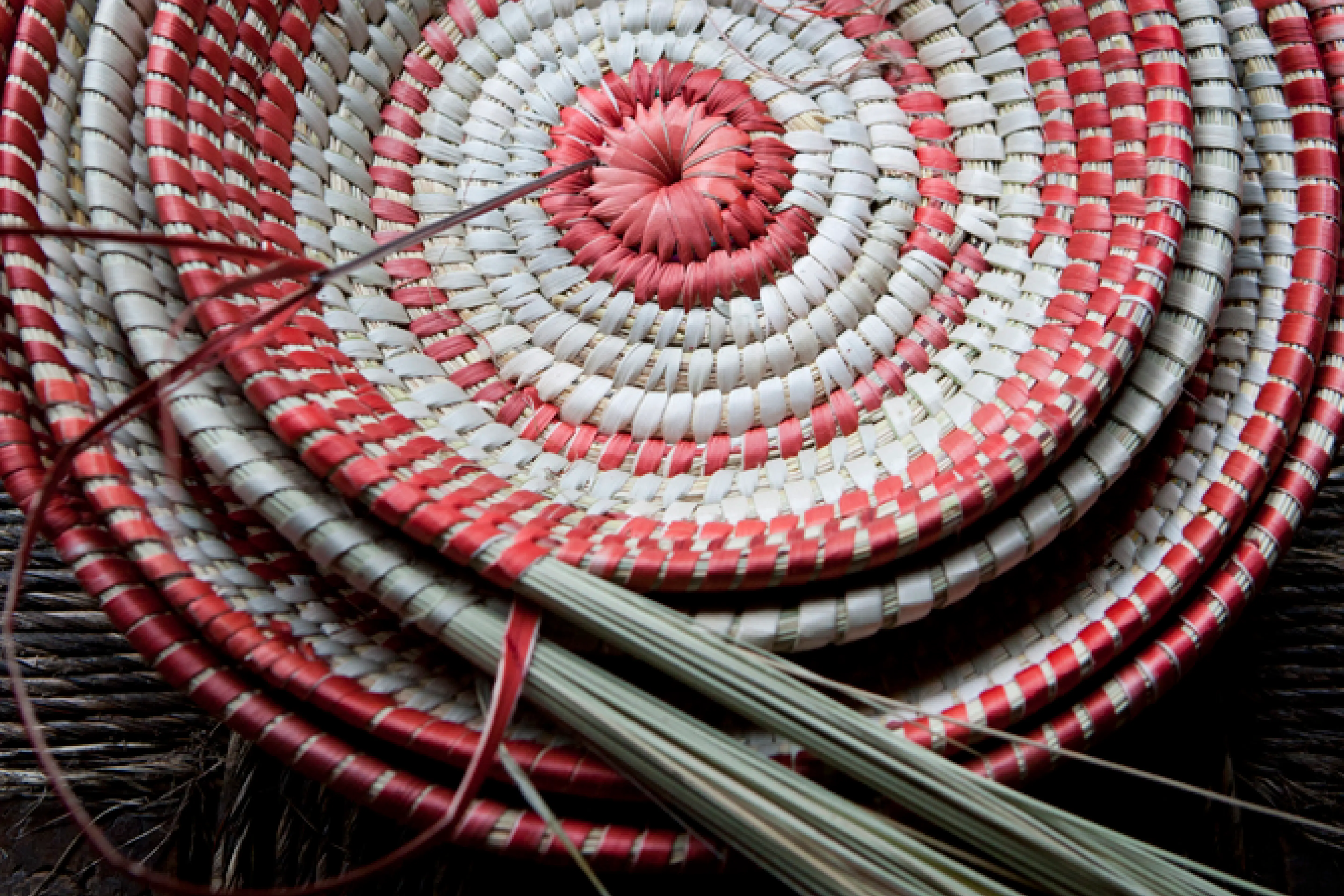
- Making of Mapuche detail. Photo by PET Lamp

- Making of Mapuche. Photo by PET Lamp

- Making of Mapuche portrait. Photo by PET Lamp

- Cristina Maribur, Cecilia Millanao, Delia Maliqueo, Eliana Rodríguez, Fabiola Millanao, Gloria Maribur, Juana Maribur, Lucía Rodríguez, María Inés Aniñir, Mariela Maribur, Rosa Hauiquiñir. Photos by PET Lamp

- Mapuche Workshop Portrait. Photo by PET Lamp

- Mapuche. Photo by PET Lamp

- Mapuche set of 3. Photo by PET Lamp

- Mapuche PET Lamp presentation in Rossana Orlandi’s patio. Photo by PET Lamp
Mapuche

We returned to Chile in 2016, this time to collaborate with the Mapuche women of Huentelolen in the Araucania Region. As usual in our workshops, they guided us through every step of the process leading to the final product. The artisan women work with a natural fiber known as ñocha, which they collect, boil, and then carefully dry, rendering it ready for weaving and shaping.
Each PET Lamp bears the distinctive and personal touch of the artisan who is free to apply colors and time-honored techniques. These women began by learning the art of cutting PET bottles and then proceeded to weave PET strips along with the vegetable fiber, utilizing wooden molds to maintain the predetermined shape. The resulting collection delves into a social community setting, featuring a native fiber and an ancient technique that has been preserved for over five centuries. PET Lamp Mapuche stands as evidence of the ability for positive projects to arise from a region characterized by conflict, actively contributing to elevating the reputation of this stunning area.

- Cooking under a Mapuche PET Lamp in private house in Madrid. Photo by Aina Gutierrez

- Ñocha fibers detail. Photo by PET Lamp

- Collecting Ñocha fibers. Photo by PET Lamp

- Ñocha left to dry at the sun. Photo by PET Lamp

- Making of Mapuche detail. Photo by PET Lamp

- Making of Mapuche. Photo by PET Lamp

- Making of Mapuche portrait. Photo by PET Lamp

- Cristina Maribur, Cecilia Millanao, Delia Maliqueo, Eliana Rodríguez, Fabiola Millanao, Gloria Maribur, Juana Maribur, Lucía Rodríguez, María Inés Aniñir, Mariela Maribur, Rosa Hauiquiñir. Photos by PET Lamp

- Mapuche Workshop Portrait. Photo by PET Lamp

- Mapuche. Photo by PET Lamp

- Mapuche set of 3. Photo by PET Lamp

- Mapuche PET Lamp presentation in Rossana Orlandi’s patio. Photo by PET Lamp

Ramingining
The story of Pet Lamp Ramingining revolves around a creative project inspired by Australian maps and indigenous culture. During a night satellite view, concentrations of inhabited areas along the coastline became apparent, giving the impression of vast empty inland territory. To our surprise, a second satellite map revealed numerous lights throughout the inland area, exposing fires set by the indigenous people to control the bush inside. The project juxtaposes the city and weaving, with a focus on Aboriginal reality.
After spending time in Ramingining and working closely with indigenous people, we organized a workshop with eight weavers. Each weaver crafted an individual lampshade, except for Mary, who crafted two based on their traditional mats. They also incorporated an umbilical cord-like form to symbolize the family bond between the weavers. The lampshades, made from local pandanus fibers, were woven together, mirroring the kinship lines seen in indigenous culture. The result is a unique and illuminated object that pays tribute to both the weavers and their cultural heritage.

- Ramingining hanging in our ACdO Studio in Madrid. Photo by ACdO

- Coloring process. Photo by PET Lamp

- Ramingining natural fibers. Photo by PET Lamp

- Ramingining natural fibers after coloring process. Photo by PET Lamp

- Leaves for coloring process. Photo by PET Lamp

- Final colors. Photo by PET Lamp

- Hands weaving detail. Photo by PET Lamp

- Hands weaving Ramingining. Photo by PET Lamp

- Making of Ramingining. Photo by PET Lamp

- Mary carrying her final single lamp. Photo by PET Lamp

- Artisans of Ramingining holding their final creation. Photo by PET Lamp

- Team portrait. Photo by PET Lamp

- BIRRIRAN GUYULA Lynette, DHAPALANY MANDHALPUYŊU Mary, DJILIRR LILIPIYANA Judith, DJULIBING MALIBIRR Julie, GEDJIN LILIPIYANA Melinda, MATJARRA GARRAWURRA Betty, MOPBORRMBRR DHALTHANGU Cecile, MUNUYGU MANDHALPUYŊU Evonne. Photos by PET Lamp

- “Yukuwa” (Feather string yam vine), 1984, an artwork by Frances Djulibing.

- Visual and conceptual similarity by PET Lamp

- PET Lamp Ramingining: Bukmukgu Guyananhawuy (Every family thinking forward) 1. Photo by PET Lamp

- Family bonds. Illustration by PET Lamp

- PET Lamp Ramingining: Bukmukgu Guyananhawuy (Every family thinking forward) 2. Photo by PET Lamp
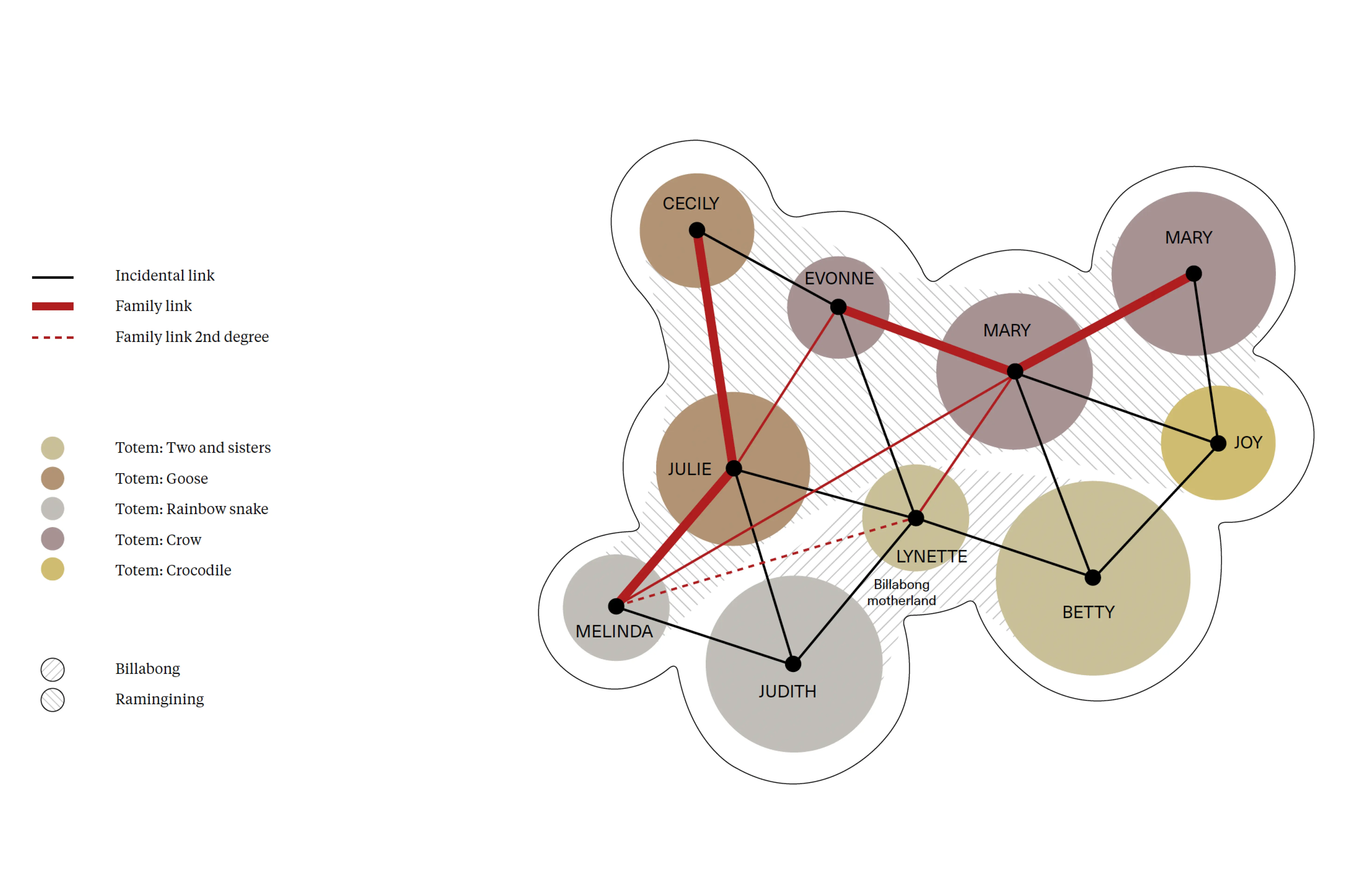
- Family bonds. Illustration by PET Lamp

- Electrification process. Photo by PET Lamp

- Electrification process. Photo by PET Lamp

- Lighted Ramingining. Photo by PET Lamp

- Lighted Ramingining. Photo by PET Lamp

- Ramingining close-up. Photo by PET Lamp
Ramingining

The story of Pet Lamp Ramingining revolves around a creative project inspired by Australian maps and indigenous culture. During a night satellite view, concentrations of inhabited areas along the coastline became apparent, giving the impression of vast empty inland territory. To our surprise, a second satellite map revealed numerous lights throughout the inland area, exposing fires set by the indigenous people to control the bush inside. The project juxtaposes the city and weaving, with a focus on Aboriginal reality.
After spending time in Ramingining and working closely with indigenous people, we organized a workshop with eight weavers. Each weaver crafted an individual lampshade, except for Mary, who crafted two based on their traditional mats. They also incorporated an umbilical cord-like form to symbolize the family bond between the weavers. The lampshades, made from local pandanus fibers, were woven together, mirroring the kinship lines seen in indigenous culture. The result is a unique and illuminated object that pays tribute to both the weavers and their cultural heritage.

- Ramingining hanging in our ACdO Studio in Madrid. Photo by ACdO

- Coloring process. Photo by PET Lamp

- Ramingining natural fibers. Photo by PET Lamp

- Ramingining natural fibers after coloring process. Photo by PET Lamp

- Leaves for coloring process. Photo by PET Lamp

- Final colors. Photo by PET Lamp

- Hands weaving detail. Photo by PET Lamp

- Hands weaving Ramingining. Photo by PET Lamp

- Making of Ramingining. Photo by PET Lamp

- Mary carrying her final single lamp. Photo by PET Lamp

- Artisans of Ramingining holding their final creation. Photo by PET Lamp

- Team portrait. Photo by PET Lamp

- BIRRIRAN GUYULA Lynette, DHAPALANY MANDHALPUYŊU Mary, DJILIRR LILIPIYANA Judith, DJULIBING MALIBIRR Julie, GEDJIN LILIPIYANA Melinda, MATJARRA GARRAWURRA Betty, MOPBORRMBRR DHALTHANGU Cecile, MUNUYGU MANDHALPUYŊU Evonne. Photos by PET Lamp

- “Yukuwa” (Feather string yam vine), 1984, an artwork by Frances Djulibing.

- Visual and conceptual similarity by PET Lamp

- PET Lamp Ramingining: Bukmukgu Guyananhawuy (Every family thinking forward) 1. Photo by PET Lamp

- Family bonds. Illustration by PET Lamp

- PET Lamp Ramingining: Bukmukgu Guyananhawuy (Every family thinking forward) 2. Photo by PET Lamp

- Family bonds. Illustration by PET Lamp

- Electrification process. Photo by PET Lamp

- Electrification process. Photo by PET Lamp

- Lighted Ramingining. Photo by PET Lamp

- Lighted Ramingining. Photo by PET Lamp

- Ramingining close-up. Photo by PET Lamp

Pikul
The essence of the Thai basketry tradition is rooted in the artisan’s serene approach, reflected in their exceptionally precise creations. Bamboo, a characteristic material of Southeast Asia, is meticulously crafted by the country's most skilled craftsmen. Selecting this material not only showcases the remarkable skills of the artisan’s, but also substantial physical labor. The bamboo is transformed into fine strips after being cut and dyed to intricate the weaving process. Crafting with this material requires the expertise of three craftsmen, each specializing in one of the manufacturing techniques essential for creating each lamp.
The PET Lamp Pikul collection draws its name from the Mimusops Elengi flower, also known as the Spanish Cherry tree, which thrives in the region's forests. This flower's geometric growth pattern serves as an inspiration for the traditional Pikul design, which is prevalent in various crafts across East Asia and Thailand.

- 7 Pikul PET Lamps for a warm atmosphere in a private dining room. Photo by PET Lamp

- Preparation of the bamboo. Photo by PET Lamp

- Weaving of bamboo. Photo by PET Lamp

- Making of Pikul detail. Photo by PET Lamp
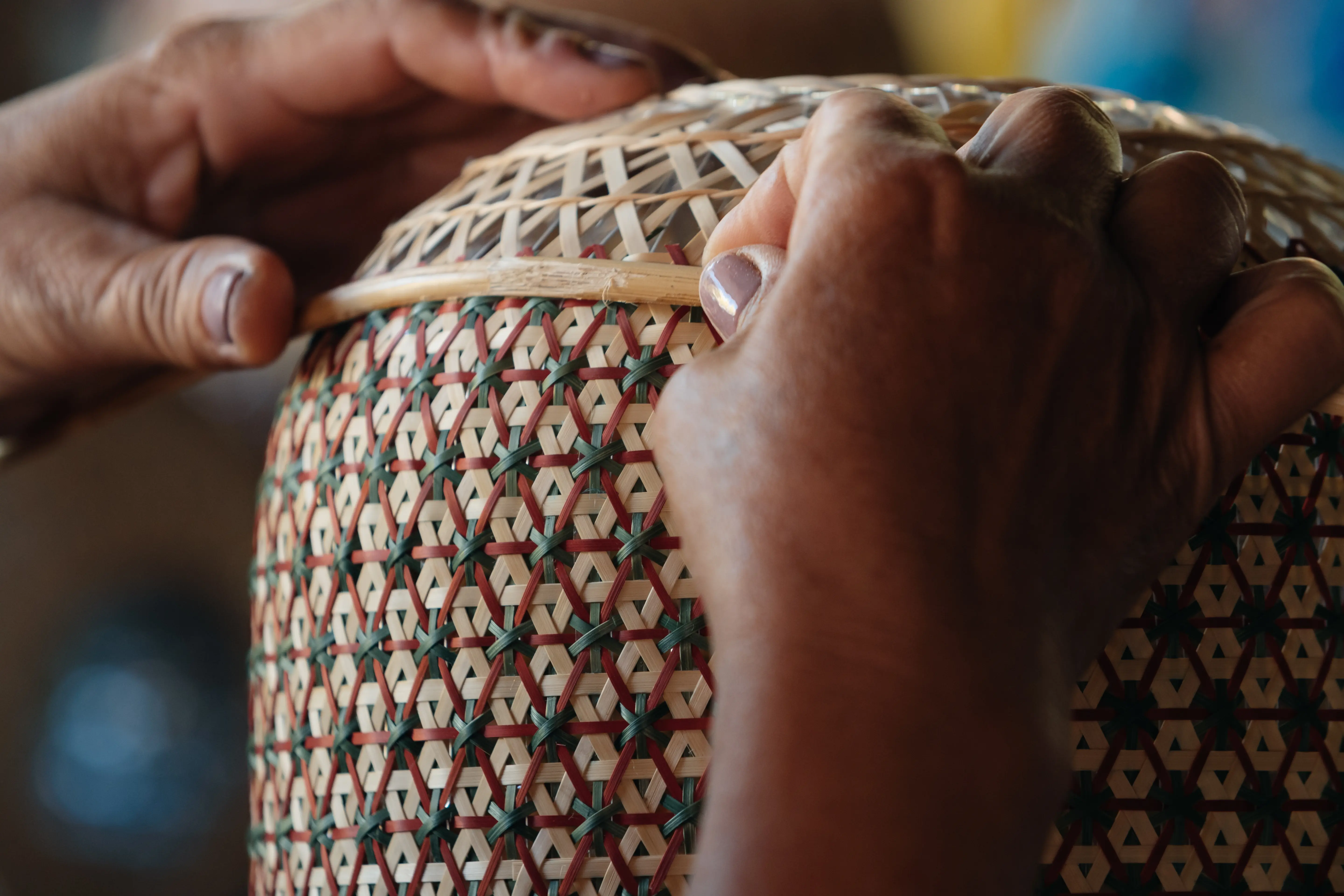
- Detail of the Pikul assembly. Photo by PET Lamp

- Making of Pikul close-up. Photo by PET Lamp

- Pikul artisans. Photos by PET Lamp
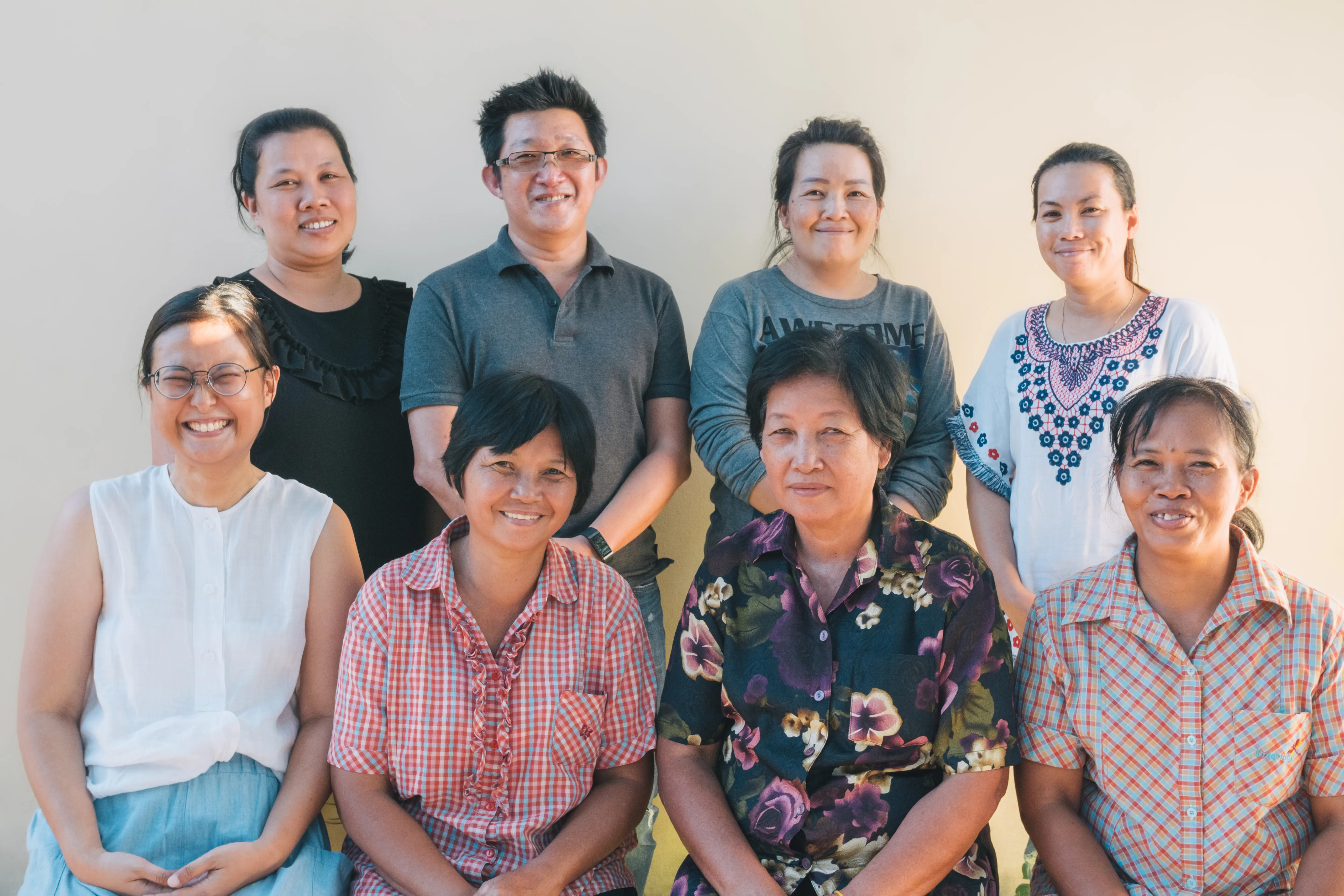
- The weavers team with Komkrit Borriboon and Nunnaree Panichkul. Photo by PET Lamp

- Pikul. Photo by PET Lamp

- Pikul set of 6. Photo by PET Lamp

- Pikul Floor PET Lamp lighting up a corner in a private house. Photo by Aina Gutierrez

- Pikul Wall PET Lamp waiting for the dinner to be served. Photo by PET Lamp

- Our ACdO Studio kitchen with 7 Pikul PET Lamps. Photo by Aina Gutierrez
Pikul

The essence of the Thai basketry tradition is rooted in the artisan’s serene approach, reflected in their exceptionally precise creations. Bamboo, a characteristic material of Southeast Asia, is meticulously crafted by the country's most skilled craftsmen. Selecting this material not only showcases the remarkable skills of the artisan’s, but also substantial physical labor. The bamboo is transformed into fine strips after being cut and dyed to intricate the weaving process. Crafting with this material requires the expertise of three craftsmen, each specializing in one of the manufacturing techniques essential for creating each lamp.
The PET Lamp Pikul collection draws its name from the Mimusops Elengi flower, also known as the Spanish Cherry tree, which thrives in the region's forests. This flower's geometric growth pattern serves as an inspiration for the traditional Pikul design, which is prevalent in various crafts across East Asia and Thailand.

- 7 Pikul PET Lamps for a warm atmosphere in a private dining room. Photo by PET Lamp

- Preparation of the bamboo. Photo by PET Lamp

- Weaving of bamboo. Photo by PET Lamp

- Making of Pikul detail. Photo by PET Lamp

- Detail of the Pikul assembly. Photo by PET Lamp

- Making of Pikul close-up. Photo by PET Lamp

- Pikul artisans. Photos by PET Lamp

- The weavers team with Komkrit Borriboon and Nunnaree Panichkul. Photo by PET Lamp

- Pikul. Photo by PET Lamp

- Pikul set of 6. Photo by PET Lamp

- Pikul Floor PET Lamp lighting up a corner in a private house. Photo by Aina Gutierrez

- Pikul Wall PET Lamp waiting for the dinner to be served. Photo by PET Lamp

- Our ACdO Studio kitchen with 7 Pikul PET Lamps. Photo by Aina Gutierrez

Bolgatanga
The specific technique known as "Pakurigo Waves" is a distinctive approach employed by a select group of master weavers within The Baba Tree team. It involves shaping the woven baskets into undulating "waves" imparting a unique and captivating sense of movement. This community comprises skilled artisans who craft their baskets using their indigenous straw Elephant grass, the primary materials for basket weaving in northern Ghana. In each piece they create, the weavers blend the rich Gurunsi weaving traditions with a contemporary and modern language, thanks to the incorporation of the distinctive wave patterns in the weaving process. These waves infuse each basket with a distinctive dynamism and rhythm.
Our experience at this workshop stands as one of the most enriching and gratifying endeavors we have ever undertaken. It allowed us to explore a country filled with surprises and to establish a close and harmonious rapport with the skilled artisans. In the process, we gained insights into a technique rich in tradition and heritage. Moreover, this experience provided an opportunity for us to introduce a modern twist to their traditional basketry by incorporating PET bottles, a solution to an ongoing environmental issue in this part of Ghana.

- Bolgatanga PET Lamp on top of our Christmas for Elle Decor Spain. Photo by PET Lamp

- Turning a plastic bottle into a Bolgatanga. Photo by PET Lamp

- Making of Bolgatanga. Photo by PET Lamp
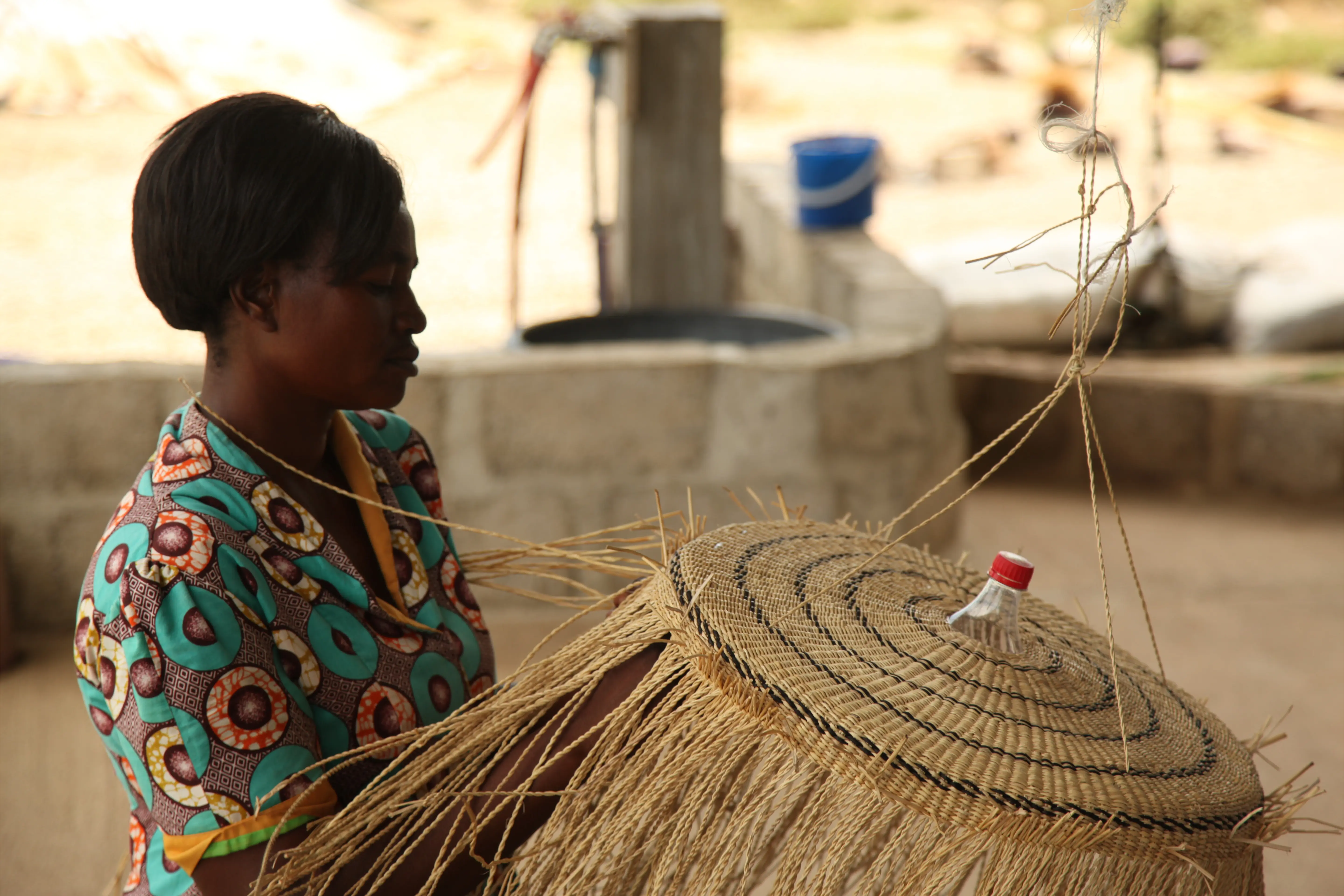
- Making of Bolgatanga. Photo by PET Lamp

- Making of Bolgatanga. Photo by PET Lamp

- Bolgatanga weaving close-up. Photo by PET Lamp

- Artisans weaving Bolgatanga’s. Photo by PET Lamp

- Anamolika Azure, Celina Nmabila Apasinore, Atule Abentara, Lizy Nmaa Akolgoyine, Matilda Ben, Mary Asoba.
Photos by PET Lamp

- Team portrait. Photo by PET Lamp
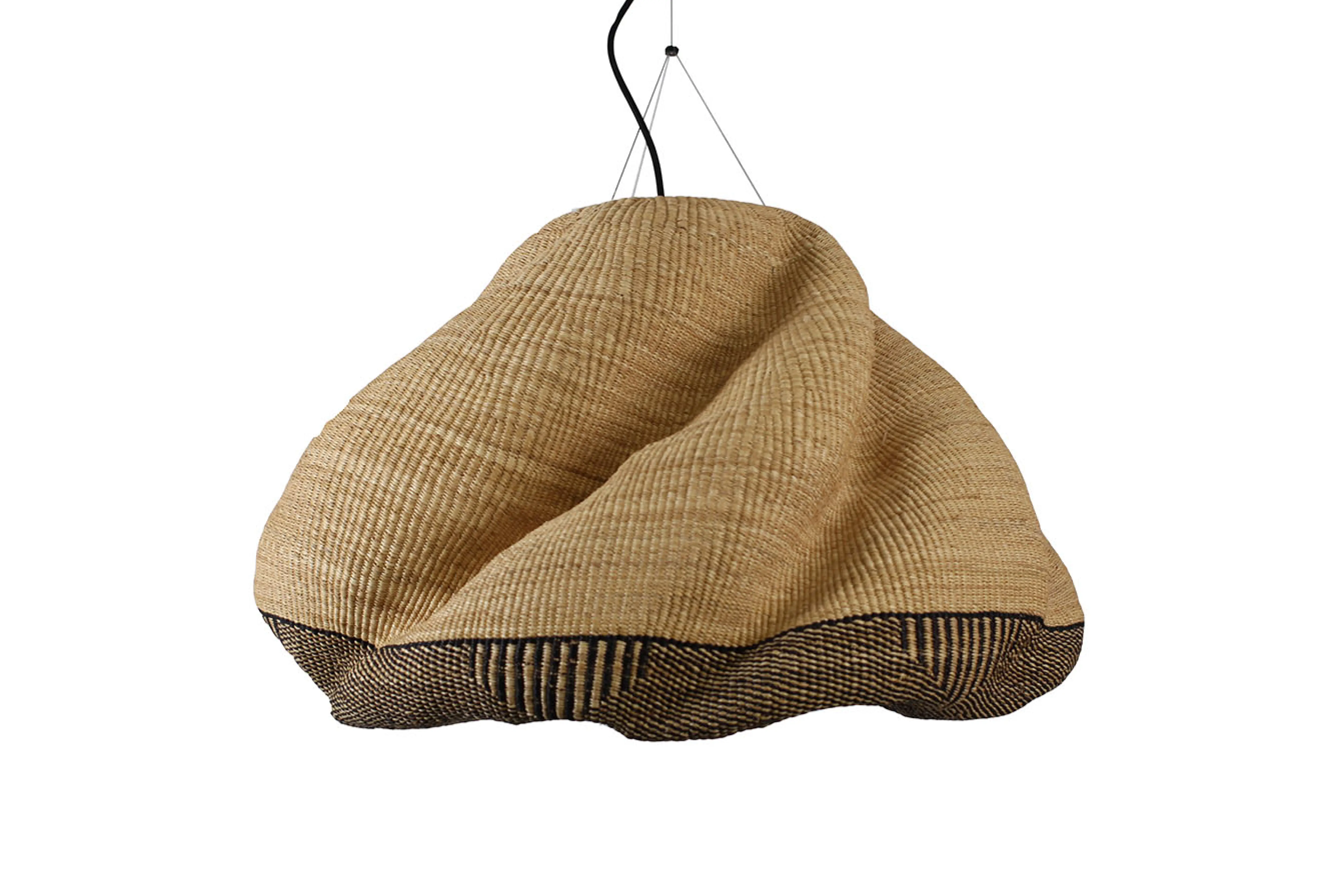
- Bolgatanga. Photo by PET Lamp

- Bolgatanga set of 12. Photo by PET Lamp

- PET Lamp Bolgatanga hanging at a Mediterranean kitchen. Photo by Andrea Pons Arquitectura

- Setting with Bolgatanga PET Lamp published by AD Spain. Photo by Manolo Yllera. Styling by Amaya de Toledo
Bolgatanga

The specific technique known as "Pakurigo Waves" is a distinctive approach employed by a select group of master weavers within The Baba Tree team. It involves shaping the woven baskets into undulating "waves" imparting a unique and captivating sense of movement. This community comprises skilled artisans who craft their baskets using their indigenous straw Elephant grass, the primary materials for basket weaving in northern Ghana. In each piece they create, the weavers blend the rich Gurunsi weaving traditions with a contemporary and modern language, thanks to the incorporation of the distinctive wave patterns in the weaving process. These waves infuse each basket with a distinctive dynamism and rhythm.
Our experience at this workshop stands as one of the most enriching and gratifying endeavors we have ever undertaken. It allowed us to explore a country filled with surprises and to establish a close and harmonious rapport with the skilled artisans. In the process, we gained insights into a technique rich in tradition and heritage. Moreover, this experience provided an opportunity for us to introduce a modern twist to their traditional basketry by incorporating PET bottles, a solution to an ongoing environmental issue in this part of Ghana.

- Bolgatanga PET Lamp on top of our Christmas for Elle Decor Spain. Photo by PET Lamp

- Turning a plastic bottle into a Bolgatanga. Photo by PET Lamp

- Making of Bolgatanga. Photo by PET Lamp

- Making of Bolgatanga. Photo by PET Lamp

- Making of Bolgatanga. Photo by PET Lamp

- Bolgatanga weaving close-up. Photo by PET Lamp

- Artisans weaving Bolgatanga’s. Photo by PET Lamp

- Anamolika Azure, Celina Nmabila Apasinore, Atule Abentara, Lizy Nmaa Akolgoyine, Matilda Ben, Mary Asoba.
Photos by PET Lamp

- Team portrait. Photo by PET Lamp

- Bolgatanga. Photo by PET Lamp

- Bolgatanga set of 12. Photo by PET Lamp

- PET Lamp Bolgatanga hanging at a Mediterranean kitchen. Photo by Andrea Pons Arquitectura

- Setting with Bolgatanga PET Lamp published by AD Spain. Photo by Manolo Yllera. Styling by Amaya de Toledo

The Collection
The PET Lamp Collection stands as the iconic culmination of a nine-year-old project, blending lampshades from all the commercial collections developed over the years. This piece combines a symphony of diverse weaving techniques, materials, patterns, languages, and cultural experiences, creating a valuable ethnographic and anthropological significance.
One glance at this composition allows users to board on a journey through Colombia, Chile, Ethiopia, Thailand, and Ghana, providing a close-up examination of both craftsmanship and design. It embraces the entire research journey, from the first workshop to the final custom components that are added to the lamps in our studio.
The installation provides a rich and diverse visual language which is proof of the harmonious collaborative work aiming to create a solution for a global problem.

- ACdO Studio, Madrid. Photo by Aina Gutierrez

- The Collection. Photo by PET Lamp

- Private Choice show in Paris. Photo by Private Show
The Collection

TThe PET Lamp Collection stands as the iconic culmination of a nine-year-old project, blending lampshades from all the commercial collections developed over the years. This piece combines a symphony of diverse weaving techniques, materials, patterns, languages, and cultural experiences, creating a valuable ethnographic and anthropological significance.
One glance at this composition allows users to board on a journey through Colombia, Chile, Ethiopia, Thailand, and Ghana, providing a close-up examination of both craftsmanship and design. It embraces the entire research journey, from the first workshop to the final custom components that are added to the lamps in our studio.
The installation provides a rich and diverse visual language which is proof of the harmonious collaborative work aiming to create a solution for a global problem.

- Bolgatanga PET Lamp on top of our Christmas for Elle Decor Spain. Photo by PET Lamp

- Turning a plastic bottle into a Bolgatanga. Photo by PET Lamp

- Making of Bolgatanga. Photo by PET Lamp

- Making of Bolgatanga. Photo by PET Lamp

- Making of Bolgatanga. Photo by PET Lamp

- Bolgatanga weaving close-up. Photo by PET Lamp

- Artisans weaving Bolgatanga’s. Photo by PET Lamp

- Anamolika Azure, Celina Nmabila Apasinore, Atule Abentara, Lizy Nmaa Akolgoyine, Matilda Ben, Mary Asoba.
Photos by PET Lamp

- Team portrait. Photo by PET Lamp

- Bolgatanga. Photo by PET Lamp

- Bolgatanga set of 12. Photo by PET Lamp

- PET Lamp Bolgatanga hanging at a Mediterranean kitchen. Photo by Andrea Pons Arquitectura

- Setting with Bolgatanga PET Lamp published by AD Spain. Photo by Manolo Yllera. Styling by Amaya de Toledo
